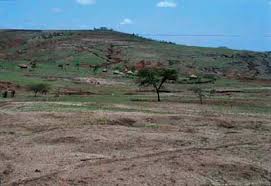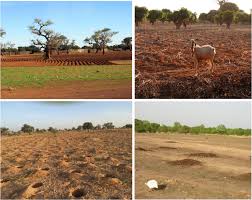Land use is a major factor in tropical soil fertility and plant nutrition. This is because every activity carried out on the soil has either positive or negative impact on the soil’s fertility status.
Land is being used in tropical regions to grow trees, crops and animals for food, as building sites for houses and roads, or for recreational purposes.
Sanchez (1976) distinguished the following land management systems in the tropics: nomadic herding, livestock ranching, shifting cultivation, subsistence tillage, and plantation agriculture.
Most land in the tropics is being used by smallholders who farm for subsistence but also may grow some cash crops.
Many soils have been improved since people started cultivation and soil improvements continue in many agricultural areas. Inputs are applied when needed by the crops, losses are minimized and environmental awareness and legislation have created agricultural practices that are ecologically and economically more sustainable.
Activities that Lead to Changes in Land Use
Obviously, soil fertility is a complex issue consisting of several attributes that interact over time. Measurements require long-term research commitment as well as detailed knowledge about spatial and temporal variability.
Most studies about the interaction between land use and soil fertility are on the profile and field scales which makes a direct link with spatial data on land cover change complicated.
However, several activities carried out on the land have direct or indirect, positive or negative effect on the soil structural composition of such land which ultimately affects the soil fertility status.
Such activities include; Cultivation (mechanized, by hand), tillage, weeding, terracing, Sub-soiling, deep ploughing, manure, compost and fertilizer applications, liming, draining, irrigation and empoldering also biocides applications on cultivated crops may affect soil properties.
Types of Land Use

The majority of land use changes are related to agricultural use of the land, including pastures. Agricultural activities change the soil chemical, physical or biological properties.
Major types of land use that relates to agriculture include the following; Nomadic herding, Livestock ranching, Shifting cultivation, Subsistence farming and plantation agriculture.
1. Nomadic Herding
Nomadic herding is the practice of keeping and grazing animals on natural pastures. It is common in the arid and semi-arid regions such as certain parts of Saudi Arabia, northern Africa and northern parts of Eurasia.
The practice resembles pastoral farming. Nomads move with their animals from one place to another in search of water and pasture for their animals. The types of animals herded vary from one region to another.
Read Also : Highlander Cat Breed Description and Complete Care Guide
They include sheep, cattle, camel, goats, donkeys and horses. The activity is a form of subsistence farming meant to feed the family.
2. Livestock Ranching
Livestock ranching focuses on rearing animals. Unlike nomadic herding, farmers do not move from one place to another in search of pasture and water, but live in settlements. Pasture lands are developed for grazing the animals.
Many areas across the globe with large pieces of land with enough grazing areas for animals practice this type of agriculture for commercial reasons.
South America, North America and Australia are some regions across the world that intensively practice commercial pastoral farming on large-scale due to low rains received in the areas.

The animals in ranches are mainly kept for wool and meat. Dairy farming is also a critical aspect of pastoral farming.
However, the activity is not sustainable because excessive grazing can lead to destruction of natural pastures. Therefore, farmers end up buying feeds for their animals, making the practice costly.
3. Shifting Cultivation
Shifting cultivation is commonly practiced in the tropics. It involves forest clearance through burning and slashing.
The cleared lands is cultivated until its fertility declines, or for three to five years or until native flora and weeds overtake it. When that happens, farmers abandon the land for a fallow period and clear another forest area for cultivation.
It is a type of subsistence farming usually done manually. People in the tropical regions such as south-east Asia tend to adopt this type of agricultural activity with a focus on growing grains.
However, due to the pressure environmentalists and activists exert to support environment protection from such unsustainable practices, the activity is declining.
4. Subsistence Farming
Subsistence farming involves growing crops and keeping animals for the sole purpose of feeding the farmer and his family. It involves the use of simple farm tools on small pieces of land.
Most subsistence farmers are believed to be poor and thus cannot afford to buy improved seeds and fertilizers. Therefore, they farm on land with low soil fertility or rough terrains.
5. Plantation Agriculture
Also known as tree crop farming, industrialized agriculture or plantation farming, commercial plantations cover large land areas. Even if practiced on a smaller piece of land, the activity has a high commercial value.
It involves the cultivation of tropical crops such as tea, rubber, coffee, coconut, cocoa, grapes, apples, spices, oranges, avocado, mangoes and palm oil. It is commonly practiced in regions with European colonial influence such as Africa, Asia and Latin America.
Colonial governments established most of the plantations in their colonies to supply the European markets with tropical crops. It requires high capital to establish with the majority of the crops grown being tree crops. Some plantation farms have processing factories.
Various farming techniques are adopted to increase farm yield because the goal of such farms is to make profits.
How Land Use Affects Soil Fertility

Land use change always affects soil quality and productivity.
On-site effects are mostly related to changes in soil organic matter content.
The most dramatic changes occur directly after a major land use conversion, such as deforestation.
Mineralization increases while the change in cover usually induces erosion and other landscape processes.
Conversion has a large short term (1-5 years) on-site impact on soil properties such as soil organic C and bulk density, whereas land use intensification has longer term (10 to 80 years) effects on soil properties.
In summary,soil fertility is a complex issue consisting of several attributes that interact over time. Measurements require long-term research commitment as well as detailed knowledge about spatial and temporal variability.
Most studies about the interaction between land use and soil fertility are on the profile and field scales which makes a direct link with spatial data on land cover change complicated.
However, several activities carried out on the land have direct or indirect, positive or negative effect on the soil structural composition of such land which ultimately affects the soil fertility status.
Majority of the land uses practiced on our tropical soils are agriculturally related and include the following; Nomadic herding, livestock ranching, shifting cultivation, subsistence tillage, and plantation agriculture. These activities affect soil fertility by changing their quality and productivity.
Read Also : Irrigation Companies Near Me: A Guide To Finding The Best Services
Frequently Asked Questions
We will update this section soon.

